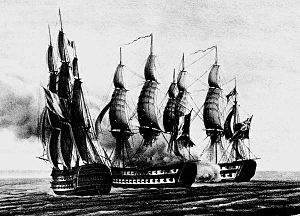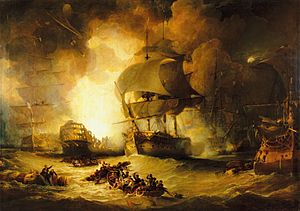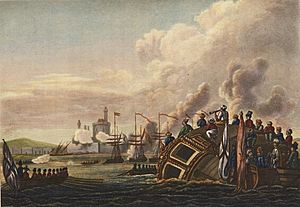HMS Swiftsure (1787) facts for kids

Indivisible and Dix-Août capture Swiftsure
|
|
Quick facts for kids History |
|
|---|---|
| Name | HMS Swiftsure |
| Ordered | 19 June 1782 |
| Builder | John & William Wells, Deptford |
| Laid down | May 1784 |
| Launched | 4 April 1787 |
| Honours and awards |
|
| Captured | 24 June 1801, by French Navy |
| Name | Swiftsure |
| Acquired | 24 June 1801 |
| Honours and awards |
Participated in Battle of Trafalgar |
| Captured | 21 October 1805, by Royal Navy |
| Name | HMS Irresistible |
| Acquired | 21 October 1805 |
| Fate | Broken up, January 1816 |
| General characteristics | |
| Class and type | Elizabeth class ship of the line |
| Tons burthen | 1612 (bm) |
| Length | 168 ft 6 in (51.36 m) (gundeck) |
| Beam | 46 ft (14 m) |
| Depth of hold | 19 ft 9 in (6.02 m) |
| Propulsion | Sails |
| Sail plan | Full-rigged ship |
| Armament |
|
HMS Swiftsure was a powerful warship known as a 74-gun third rate ship of the line. She was part of the British Royal Navy. This ship had an exciting career, fighting in major battles during the French Revolutionary and Napoleonic Wars.
Swiftsure was first a British ship. Then, she was captured by the French for a short time. Later, the British captured her back! She fought for Britain at the famous Battle of the Nile. Then, she fought for France at the equally famous Battle of Trafalgar.
Contents
Building and First Days
Swiftsure was ordered on June 19, 1782. She was built by John & William Wells in Deptford, England. The ship was part of the Elizabeth class of warships.
Workers started building her in May 1784. She was officially launched on April 4, 1787. Building Swiftsure cost a lot of money, about £31,241. She was then prepared for service, which cost even more.
Swiftsure began her service in June 1790. Her first captain was Sir James Wallace. She sailed to Plymouth for more preparations. After this, she served in the English Channel.
In September 1791, the ship was taken out of service for a big repair. She returned to duty in July 1793. Captain Charles Boyles was now in command. Swiftsure became the main ship for Rear-Admiral Sir Robert Kingsmill. She operated near Ireland in 1794.
Capturing the Atalante
On May 7, 1794, Swiftsure chased and captured a French warship. This ship was the 36-gun frigate Atalante. The chase lasted 39 hours. Atalante had 38 guns and 274 crew members. Ten French sailors were killed, and 32 were wounded. Only one British sailor was killed. After this, Swiftsure returned to Plymouth for repairs. The British Navy later used Atalante as HMS Espion.
Journey to Jamaica and New Captains
Swiftsure left Britain for Jamaica on May 14, 1795. In December 1795, Captain Robert Parker took command. He sailed her back to Britain. The ship was repaired again at Portsmouth. In October 1796, Captain Arthur Phillips took over. He was followed by Captain John Irwin in September 1797. A month later, Captain Benjamin Hallowell became her commander.
The Battle of the Nile
Captain Hallowell was still in charge of Swiftsure in 1798. He was ordered to join Horatio Nelson's fleet. They were watching the French fleet near Toulon. The French escaped and invaded Egypt in July. Nelson and his fleet chased them. They found the French ships anchored in Aboukir Bay on August 1.
Swiftsure was not with Nelson's main fleet at first. She was scouting near Alexandria. She arrived at the battle after dark. It was hard to tell British and French ships apart in the darkness and smoke. Hallowell decided to wait to fire until his ship was in position. As he moved closer, he saw a damaged ship. He thought it was French, but it was actually HMS Bellerophon. This British ship had been badly damaged by the huge French ship Orient.
Hallowell sailed Swiftsure into the bay. He anchored his ship between the French ships Franklin and Orient. He then began firing at them. After an hour, a fire started on the Orient. Hallowell ordered his crew to focus their fire on the burning area. Another British ship, HMS Alexander, also fired on the Orient. The French began to leave their burning ship. Some were rescued by British ships, including Swiftsure.
The fire on Orient grew out of control. Swiftsure and other British ships moved away. But when Orient exploded at 10 PM, Swiftsure was still close enough to be hit by flying debris.
After the Orient exploded, Swiftsure and HMS Defence kept fighting the Franklin. The Franklin eventually surrendered. Swiftsure then helped to drive the French ship Tonnant ashore. During the battle, Swiftsure had seven sailors killed and 22 wounded. Captain Hallowell received a special Gold Medal for his bravery.
After the battle, Swiftsure helped take over Aboukir island. They destroyed some enemy guns there. On August 10, Swiftsure captured a 16-gun French ship called Fortune.
Service in Egypt and Italy
Swiftsure stayed near Egypt for a while. Then, in February 1799, she joined Nelson's fleet in Palermo. She later sailed to Naples and helped restore the monarchy there. The ship then cruised along the Italian coast. She helped capture several French forts.
In August, Swiftsure was sent to Civitavecchia. Captain Hallowell was to negotiate with the French army there. But before he finished, Swiftsure was ordered to Gibraltar, then to Lisbon. She arrived in Lisbon on November 30. While cruising, she captured two merchant ships in December.
In February 1800, Swiftsure was caught in a bad storm. She was badly damaged and had to return to Gibraltar for repairs. Back at sea, she helped capture two French frigates and several merchant ships in April. She also captured a Spanish schooner. Swiftsure then became the main ship for Sir Richard Bickerton. She helped block French ships in Cadiz.
Later, Swiftsure joined Lord Keith's fleet. This fleet helped British soldiers land at Aboukir on March 8, 1801. Swiftsure′s sailors helped fight off French attacks on land. Because many of her crew were wounded or sick, 80 of her best men were sent to other ships. Swiftsure was then sent to Malta to escort other ships.
On January 8, 1801, another British ship captured a French ship called St. Roche. St. Roche was carrying wine and other goods. Swiftsure and several other British ships were nearby and shared in the prize.
All the officers and crew of Swiftsure who served in the Egyptian campaign (March to September 1801) later received a special medal. It was called the Naval General Service Medal, with a clasp for "Egypt."
Captured by the French
On June 10, 1801, Captain Hallowell learned that a French fleet was at sea. He decided to join Sir John Warren's British fleet. But on June 24, Swiftsure met the French fleet. The French ships were faster and Swiftsure was already damaged and short on crew.
Two French ships, Indivisible and Dix-Août, fired at Swiftsure. They shot away her masts and sails, making her unable to move. Captain Hallowell had to surrender. Two of Swiftsure′s men were killed, two were badly wounded, and six others were hurt. The French lost 33 men.
When Captain Hallowell returned to Britain, he had to face a military trial. This was normal for a captain who lost his ship. But he was found innocent and honored. The French Navy then took Swiftsure into their service, keeping her name.
Swiftsure was part of the French Navy for about four years. She was commanded by Captain Charles-Eusebe l'Hôpitalier-Villemadrin.
The Battle of Trafalgar
On October 21, 1805, Swiftsure sailed out with the combined French and Spanish fleets. They were going to fight the British in the Battle of Trafalgar. During the battle, Swiftsure was near the back of the French line of ships.
She was fired upon by the British ship HMS Colossus. After exchanging fire, Swiftsure lost her main topmast. Many of her guns were silenced. She began to drift away. Her crew worked to regain control. They started firing at Colossus again. But then, HMS Orion came through the smoke. She fired many powerful shots into Swiftsure′s stern (the back of the ship).
Swiftsure had her mainmast, back railing, and steering wheel shot away. Most of the guns on her main deck were broken. Captain Villemadrin tried to keep fighting. But eventually, he had to surrender. During the battle, Swiftsure had 68 sailors killed and 123 wounded.
After the battle, HMS Dreadnought began towing Swiftsure. But a storm caused the tow line to break. By October 23, Swiftsure was drifting towards Cadiz. The British frigate HMS Phoebe managed to reattach a tow line. Her carpenters went aboard Swiftsure to stop the leaks. The bad weather made the line break again. But the men from Phoebe kept control of Swiftsure. They anchored her on October 26. HMS Polyphemus then towed her into Gibraltar.
Swiftsure was repaired at Gibraltar. In April 1806, she was put back into service under Captain George Digby. She sailed home, arriving at Chatham on June 11, 1806.
By this time, another British ship named HMS Swiftsure was already in service. This new Swiftsure had even been at Trafalgar. So, the captured Swiftsure was renamed HMS Irresistible. She was then put into storage.
In March 1808, she was recommissioned under Captain George Fowke. She was used as a prison ship at Chatham. She served in this role until she was taken apart in January 1816.
Images for kids
-
The Battle of Trafalgar, 21 October. On the left the French Swiftsure about to be recaptured by the British, next to her the Spanish Bahama, then HMS Colossus firing into the French Argonaute. Painting by Richard Henry Nibbs











